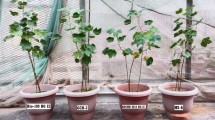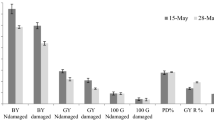Abstract
—The response of two cotton varieties (TCH 1002 and 77/10) and two hybrids (TCHB 213 and DCH 32) to damage caused by the American bollworm, Helicoverpa armigera was evaluated under two spacings and three fertiliser levels each. Variety TCH 1002 was less damaged than 77/10, whereas between hybrids, DCH 32 was less preferred than TCHB 213. Damage was higher when the varieties were grown at a spacing of 50 × 20 cm and the hybrids at a spacing of 120 × 45 cm compared to 75 × 30 and 120 × 60 cm, respectively. Increasing the amount of fertiliser applied did not have any significant effect on damage caused by the pest. Tannin and gossypol contents were found to influence levels of damage caused by H. armigera. A combination of high tannin and gossypol resulted in reduced damage. The highest tannin content in varieties was recorded in leaves of TCH 1002 grown at a spacing of 75 × 30 cm, with a fertiliser level of 120:60:60 NPK kg/ha. The highest gossypol content was recorded in flowers of TCH 1002 under similar spacing and management levels. In the hybrids, the highest tannin and gossypol contents were recorded when DCH 32 was grown at 120 × 60 cm spacing with a fertiliser regime of 120:60:60 NPK kg/ha. Cotton was damaged to a greater extent when grown at a closer spacing. Increasing levels of nitrogen resulted in higher damage levels.
Résumé
—La réaction de deux variétés et deux hybrides de coton aux dégâts dus au charançon du cotonnier américain, Helicoverpa armigera a été évaluée à deux espacements et 3 niveaux de fumure chacun. Des deux variétés étudiées, TCH 1002 a été moins endommagée que la 77/10, tandis qu’entre les deux hybrides, DCH 32 a été moins préféré que le TCHB 213. Les dégâts ont été plus accentués quand les variétés étaient cultivées à l’écartement de 50 × 20 cm que quand elles l’étaient à l’écartement de 75 × 30 cm et les hybrides à l’écartement de 120 × 45 cm plutôt qu’à celui de 120 × 60 cm. L’amendement à l’aide de fumures n’a pas eu de résultat significatif concernant les dégâts causés par les ravageurs. La teneur en tanin et en gossypol a influençé les niveaux de dégâts dus à H. armigera. La combinaison d’une forte teneur en tanin et en gossypol chez les variétés a causé une réduction des dégâts. La teneur la plus élevée en tanin dans les variétés a été enregistrée dans les feuilles sur TCH 1002 quand il était cultivé à l’écartement de 75 × 30 cm, et un niveau de fumure de 120:60:60(NPK) kg/ha. La plus forte teneur en gossypol dans les fleurs a été enregistrée dans des conditions semblables. Chez les hybrides, les plus fortes teneurs en tanin et en gossypol ont été enregistrées quand DCH 32 était cultivé à l’écartement de 120 × 60 cm et un regime de fumure de 120:60:60 NPK kg/ha. Il y a eu plus de dégâts sur coton à un espacement plus rapproché. L’augmentation du niveau d’azote a aussi entraîné une augmentation des dégâts.
Similar content being viewed by others
References
Abdel Rahman A. A. and Saleem M. B. A. (1978) Ann. Report 1976–78, Entomol. Section, Gezira Res. Station, Agric. Res. Wad Medani, Sudan.
Ball A. A. (1967) Estimation of gossypol in infected or chemically irradiated tissues of Gossypium sp. Phytopathology 57, 759–764.
Bell A. A., Stipanovic R. D., Elzen G. W. and Williams H. J. (1986) Structural and genetic variations of natural pesticides in pigment glands of cotton (Gossypium). In Allelochemicals—Role in Agriculture and Forestry (Edited by Waller R.), pp. 477–490. ACS Symposium series no. 330.
Bhatia S. K. (1990) Management of insecticide resistance in Heliothis armigera. In Heliothis Management—Proceedings of National Workshop, pp. 132–141. Tamil Nadu Agricultural University, Coimbatore, India.
Bottger G. T. and Patana R. (1966) Growth, development and survival of certain Lepidoptera fed gossypol in the diet. J. Econ. Entomol. 59, 1166–1168.
Burns R. E. (1971) Method for estimation of tannin in grain sorghum and other food stuffs. Agron. J. 63, 511–512.
El Amin E. M. and Ahmed M. A. (1991) Strategies for integrated cotton pest control in the Sudan. 1—Cultural and legislative measures. Insect Sci. Applic. 12, 547–552.
Ilango K. and Uthamasamy S. (1989) Influence of spacings and fertilizer levels on the incidence of bollworm bollrot complex in three varieties of cotton (Gossypium hirsutum). Appl. Agric. Res. 4, 173–178.
Jayaraj S., Rangarajan A. V., Gopalan M., Ramakrishnan C., Manoharan T. and Thangaraju D. (1990) Biology and bionomics of Heliothis armigera Hübner and pest surveillance—retrospect. In Heliothis Management. Proceedings of National Workshop, pp. 36–45. Tamil Nadu Agricultural University, Coimbatore, India.
Lukefahr M. J. and Martin D. F. (1966) Cotton plant pigments as a source of resistance to the bollworm and tobacco budworm. J. Econ. Entomol. 59, 176–179.
Lukefahr M. J., Shaver T. N. and Parrott M. L. (1969) Sources and nature of resistance in Gossypium hirsutum to bollworm and tobacco budworm. Beltswide Cotton Prod. Res. Conf. 81.
McCaffery A. R., King A. B. S., Walker A. J. and ElNayir H. (1989) Resistance to synthetic pyrethroids in the bollworm Heliothis armigera from Andhra Pradesh, India. Pesticide Science 27, 65–76.
Norris D. M. and Kogan M. (1980) Biochemical and morphological bases of resistance. In Breeding Plants Resistant to Insects (Edited by Maxwell F. G. and Jennings P. R.), pp. 23–51. John Wiley and Sons, New York.
Nyambo B. T. (1985) Cotton insect resistance studies in the western cotton growing areas of Tanzania. Insect Sci. Applic. 6, 379–384.
Rangarajan A. V., Mahadevan N. R., Ganapathy S. and Mahalingam B. (1974) Effect of N, P, and K nutrition on pest incidence in sunflower. Potash Newsletter 9, 27–29.
Schmutterer H. (1969) Pests of Crops in Northeast and Central Africa. Gustav Verlag-Stuttgart, W. Germany.
Stipanovic R. D., Altaian D. W., Begin D. L. and Benedict J. H. (1988) Terpenoid aldehydes in upland cottons; analysis by aniline and HPLC methods. J. Agric. Food Chem. 36, 509–515.
Taneja S. L. and Dhindwal A. S. (1982) Bollworm incidence as affected by sowing date, nitrogen application, and plant population of upland cotton. Indian J. Plant Prot. 10, 1–6.
Vander S. J. W. (1988) Feeding of the American bollworm on cotton. Plant Protection News, 12, 5.
Withers W. A. and Carruth F. E. (1915) Gossypol, the toxic substance in cottonseed meal. J. Agric. Res. 7, 261–288.
Zueuro G. R., Benedict J. H. and Segers J. C. (1983) No-choice study of plant-insect interactions for Heliothis zea (Boddie) (Lepidoptera: Noctuidae) on selected cottons. Environ. Entomol. 12, 1833–1836.
Author information
Authors and Affiliations
Rights and permissions
About this article
Cite this article
Ramnath, S., Uthamasamy, S. Effect of Genotype and Cultural Practices on Helicoverpa armigera Damage to Cotton. Int J Trop Insect Sci 16, 207–215 (1995). https://doi.org/10.1017/S1742758400017124
Accepted:
Published:
Issue Date:
DOI: https://doi.org/10.1017/S1742758400017124




